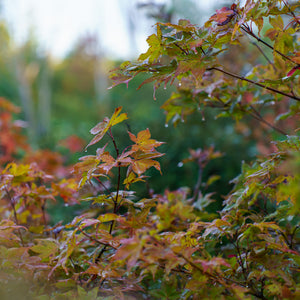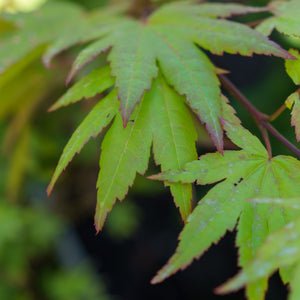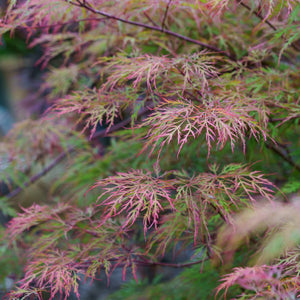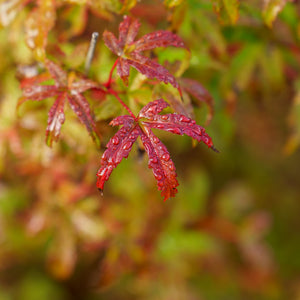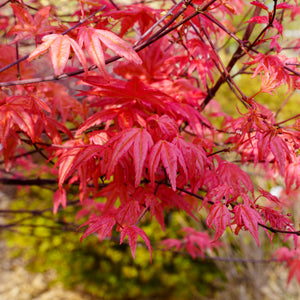The Japanese Maple Guide
Japanese maples (Acer palmatum, Acer japonicum, and Acer shirasawanum) are prized for their elegant form, delicate foliage, and vibrant seasonal color. Native to Japan and surrounding regions, these deciduous trees and shrubs have become beloved features in gardens across North America. With hundreds of cultivars ranging from upright trees to weeping dwarfs, Japanese maples offer unmatched versatility, whether you're designing a woodland retreat, a container garden, or a refined courtyard.

About
Japanese maples come in a wide range of leaf shapes, sizes, and growth habits. The three primary species used in ornamental horticulture are:
- Acer palmatum – The most widely cultivated species, known for finely dissected or palmate leaves in shades of green, red, purple, and variegated combinations.
- Acer japonicum – Typically larger-leaved, with a more rugged form and brilliant fall color; notable cultivars include ‘Aconitifolium’ and ‘Vitifolium’.
- Acer shirasawanum – Compact and slow-growing, with rounder leaves and upright structure. Often used for patio trees or accent specimens.
Notable cultivars from this extensive group include:
- ‘Bloodgood’, ‘Fireglow’, and ‘Tamukeyama’ – dependable reds with upright or cascading habits
- ‘Seiryu’ and ‘Viridis’ – lacy-leafed green cultivars, both upright and weeping
- ‘Orange Dream’, ‘Peaches and Cream’, and ‘Katsura’ – colorful spring foliage in orange, pink, or yellow
- ‘Shishigashira’, ‘Twombly’s Red Sentinel’, and ‘Mikawa Yatsubusa’ – dense and sculptural for formal or tight spaces
Most Japanese maples are slow to moderate growers, adding structure and texture without overpowering a garden. Their delicate appearance belies a hardy constitution—many are cold-tolerant and long-lived when sited correctly.
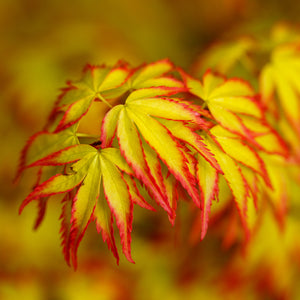
PLANTING
Proper planting is essential to support the longevity and structure of Japanese maples.
USDA Hardiness Zones:
- Acer palmatum: Zones 5–8
- Acer japonicum and Acer shirasawanum: Zones 4–8 (some selections hardy to Zone 3)
Soil: Well-drained, slightly acidic soil enriched with organic matter. Avoid heavy clay or alkaline soils. Japanese maples are sensitive to overly wet or compacted conditions.
Sunlight:
- Red-leaved varieties generally tolerate full sun in cooler climates but benefit from afternoon shade in hot zones.
- Green or variegated cultivars prefer dappled sunlight or morning sun with afternoon protection to prevent leaf scorch.
Watering: Regular watering is essential during the first two years. Even once established, Japanese maples prefer consistent moisture, especially during summer heat.
Spacing:
- Dwarf cultivars (e.g., ‘Shaina’, ‘Mikawa Yatsubusa’): 4–6 feet apart
- Medium trees (e.g., ‘Bloodgood’, ‘Moonfire’): 8–12 feet apart
- Large, spreading types (e.g., ‘Osakazuki’, ‘Vitifolium’): 15–20 feet apart
Planting Time: Spring or fall is ideal, avoiding extreme heat or cold. Fall planting allows roots to establish before winter dormancy.
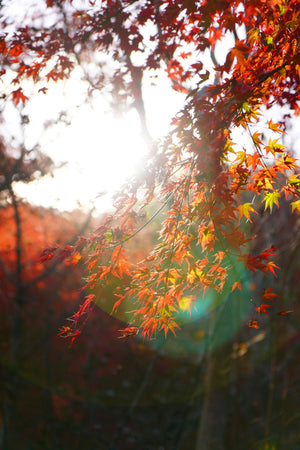
CARE
Japanese maples are generally low-maintenance but benefit from seasonal attention to maintain their health and shape.
Watering: Water deeply and consistently during dry periods, particularly in the first few years. Mulching helps retain moisture and reduce temperature fluctuations.
Fertilizing: Light feeding in early spring with a slow-release fertilizer designed for acid-loving plants can support healthy growth. Avoid excessive nitrogen, which may lead to weak or leggy branches.
Pruning:
- Best done in late winter or early spring before bud break.
- Light pruning can also be done in summer to refine shape.
- Remove deadwood, crossing branches, or branches that disrupt the natural structure. Avoid heavy pruning, especially in hot weather.
Pests & Diseases: Generally pest-resistant. Occasional aphids or scale can appear but are rarely problematic. Root rot can occur in poorly drained soils.
Mulching: A 2–3 inch layer of mulch around the base will moderate soil temperature, suppress weeds, and protect shallow roots. Keep mulch a few inches away from the trunk.
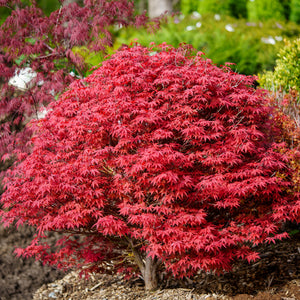
HOW TO USE
Japanese maples are celebrated for their artistic form and are widely used as focal points, specimens, or companion plants in layered designs. Their versatility makes them essential for refined, tranquil landscapes.
Focal Point: Cultivars like ‘Bloodgood’, ‘Orangeola’, or ‘Seiryu’ are perfect as standalone specimens in lawns, courtyards, or entryways. Their striking foliage and sculptural form naturally draw the eye and serve as the centerpiece of any design.
Mixed Borders: Use Japanese maples in combination with shade perennials such as ferns, hostas, heuchera, and bleeding hearts. The delicate canopy casts dappled light, creating perfect conditions for understory planting.
Woodland Gardens: Acer japonicum and Acer shirasawanum thrive in woodland edges or shaded groves. Their naturalistic appearance blends beautifully with native shrubs and trees like dogwood, redbud, or viburnum.
Containers and Courtyards: Dwarf and compact varieties like ‘Shaina’, ‘Mikawa Yatsubusa’, or ‘Peve Starfish’ are ideal for large containers on patios, balconies, or terraces. Ensure proper drainage and protect roots in cold winters.
Japanese and Zen Gardens: Japanese maples are essential to Japanese garden design. Pair with rocks, moss, gravel, and bamboo to create contemplative scenes and soft transitions between landscape features.
Fall Foliage Displays: Select cultivars like ‘Osakazuki’, ‘Aconitifolium’, and ‘Trompenburg’ for show-stopping fall color in shades of crimson, scarlet, and orange. Combine with ginkgo, fothergilla, and oakleaf hydrangea for layered autumn impact.
Urban and Small-Space Gardens: Columnar or dwarf selections such as ‘Twombly’s Red Sentinel’, ‘Winter’s Columnar Red’, or ‘Kiyohime’ are well-suited to narrow spaces and provide year-round structure without overwhelming a compact site.
Companion Planting: Combine Japanese maples with groundcovers like epimedium, ajuga, or Japanese forest grass. For seasonal variety, surround them with spring bulbs or edge them with coral bells for color contrast.

Common Questions
How to prune a Japanese maple? Use sharp, clean tools to remove dead, damaged, or crossing branches. Light pruning in late winter or early spring is best. Focus on enhancing natural form—avoid excessive thinning or heading back branches.
When to prune Japanese maple? Late winter or early spring, before new growth begins. Minor shaping can be done in mid to late summer, but avoid pruning during leaf-out or heatwaves.
How to plant a Japanese maple? Dig a hole twice as wide and no deeper than the root ball. Place the tree so the root flare is level with the soil. Backfill with native soil, water deeply, and mulch around the base.
How big do Japanese maples get? Size depends on the cultivar. Dwarfs stay under 5 feet, while larger selections can grow 15–25 feet tall and wide over several decades.
How fast do Japanese maples grow? They grow slowly to moderately—typically 6–12 inches per year depending on conditions and cultivar. Growth may slow further as trees mature.
How to propagate a Japanese maple? Propagation is usually done by grafting for specific cultivars. Seed propagation is possible but will not yield true-to-type offspring. Softwood cuttings can be rooted with effort but have a lower success rate.
How to care for Japanese maple? Water consistently, mulch generously, protect from strong sun or wind, and prune carefully. Avoid overfertilizing or planting in poorly drained soils.
When to plant Japanese maple? Spring or fall is best. Fall planting gives roots time to establish before winter. Avoid planting in extreme summer heat or during winter freezes.
Do deer eat Japanese maple? Yes, deer may browse tender new growth and young trees. In deer-prone areas, fencing or repellents may be necessary for protection.
Do Japanese maples lose their leaves? Yes, they are deciduous and drop their leaves in fall. Many cultivars display vivid fall colors before dormancy, making them highly ornamental even in leaf drop.
Conclusion
Japanese maples offer unmatched elegance, versatility, and seasonal interest in every part of the landscape. With their sculptural shapes, colorful foliage, and tolerance for containers or gardens large and small, these trees serve as a foundation for thoughtful design. Whether you're planting a specimen tree or layering them into a woodland border, Japanese maples provide year-round beauty and decades of enjoyment with minimal care.
The Japanese Maple Collection
Sold Out

